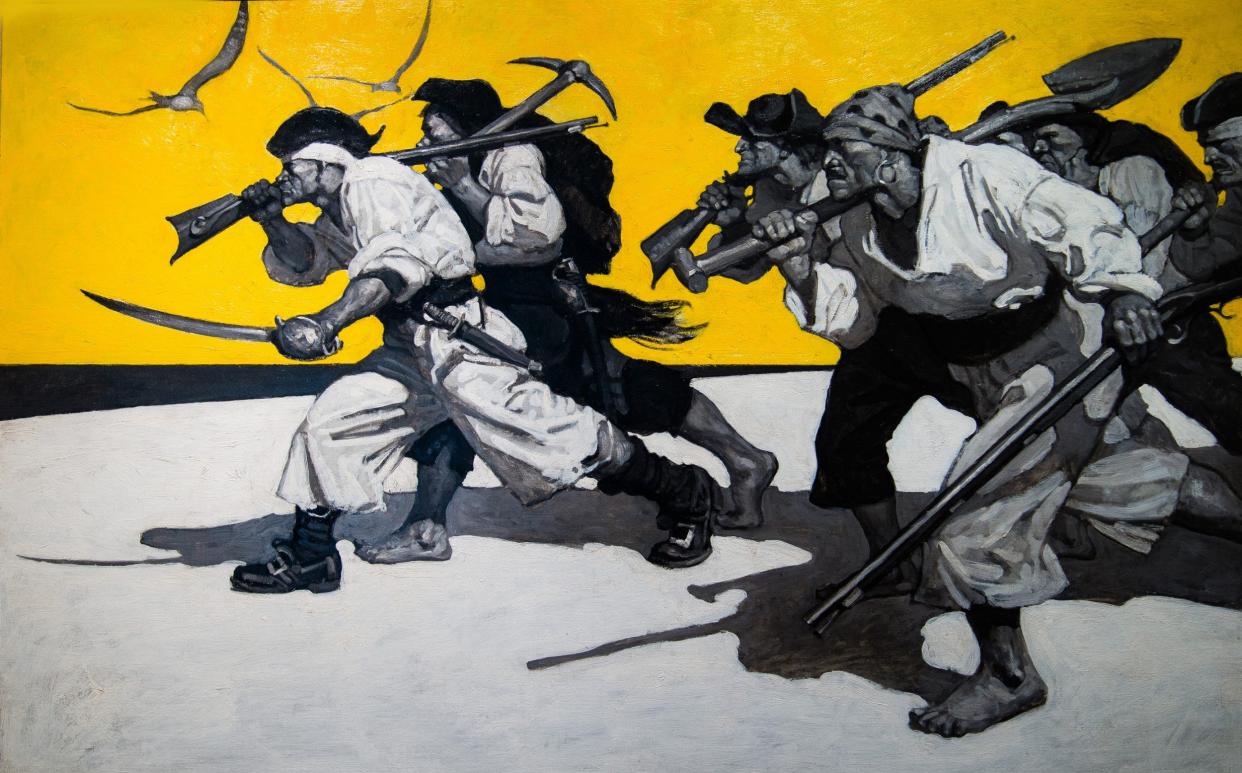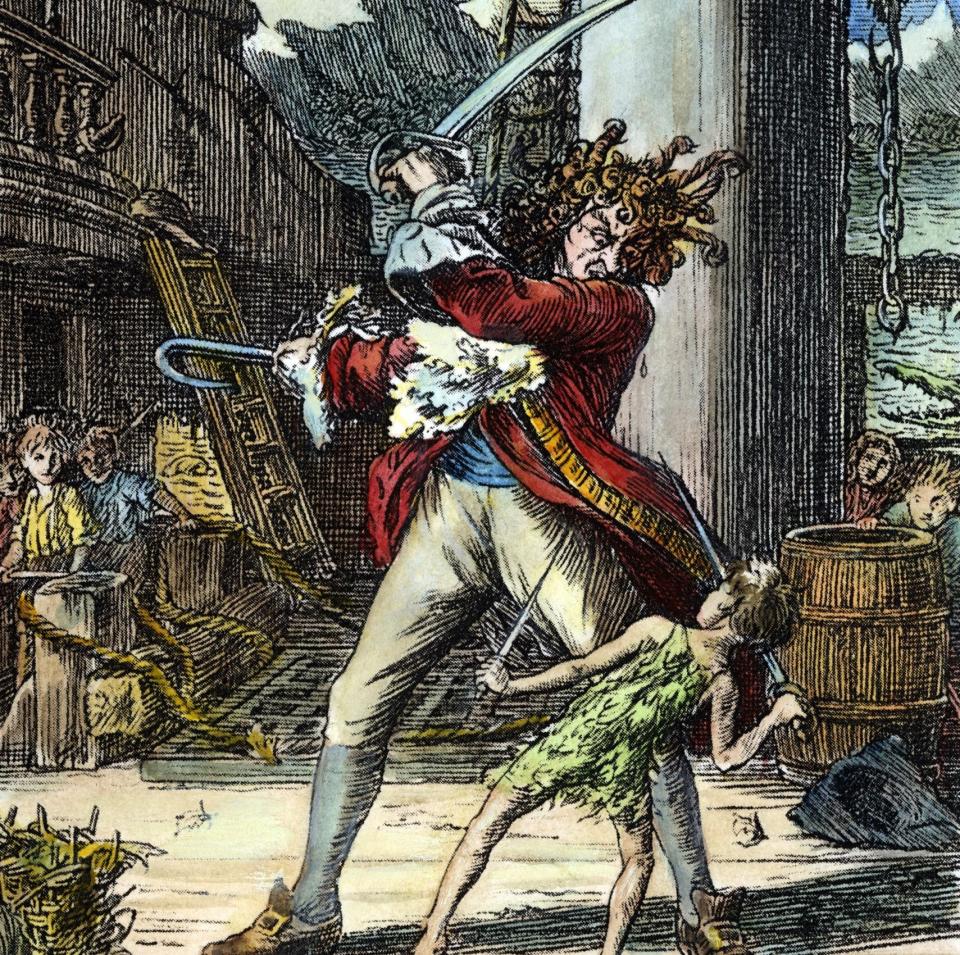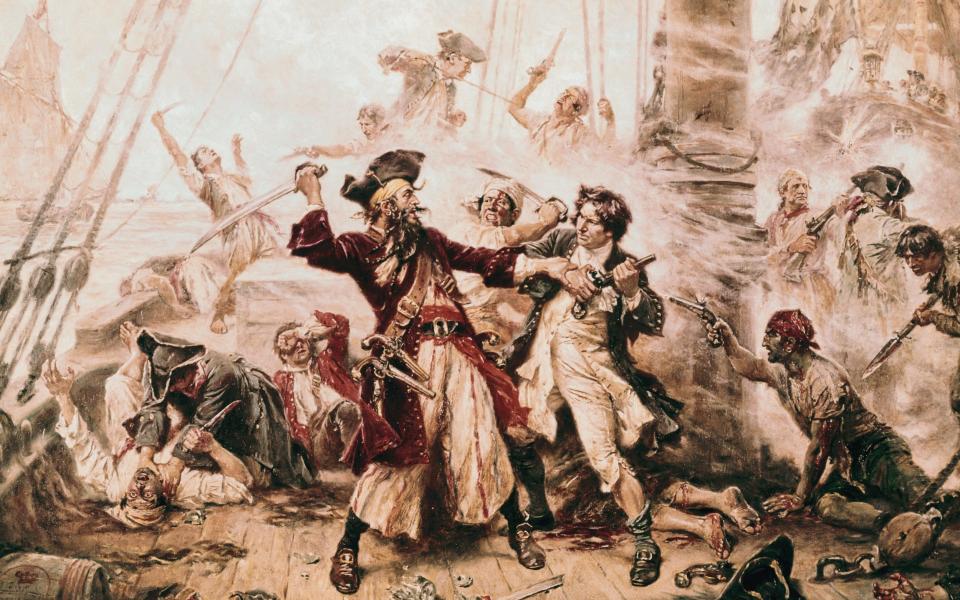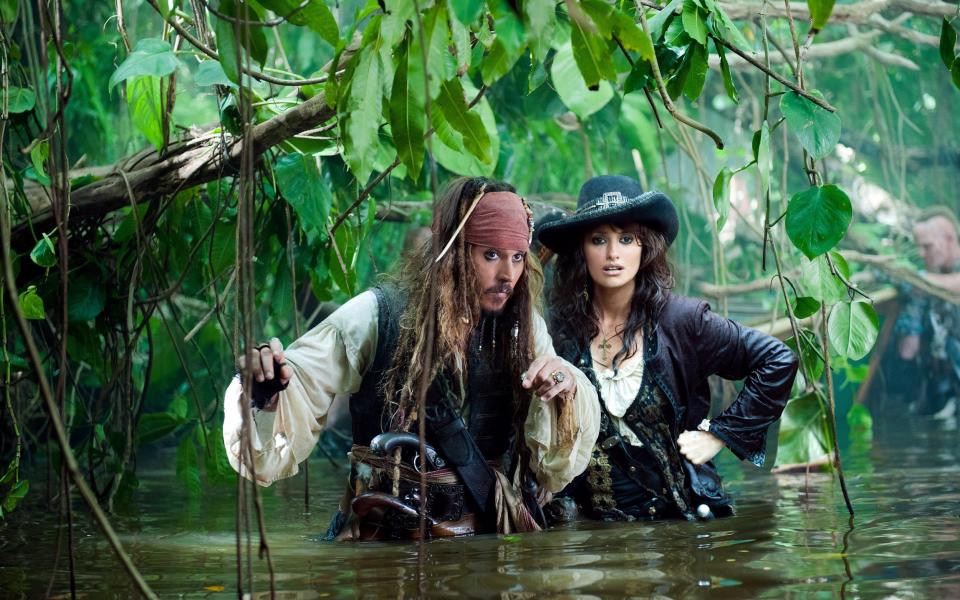How a 300-year-old book made us fall in love with pirates

- Oops!Something went wrong.Please try again later.
- Oops!Something went wrong.Please try again later.
It is perhaps the most influential book on pirates ever to have been written, the inspiration for never-ending tales of treasure and terror on the high seas. Yet the identity of its author remains a mystery. Three hundred years ago, in 1724, the pseudonymous author “Captain Charles Johnson” published a pair of volumes under the hefty title A General History of the Robberies and Murders of the Most Notorious Pyrates.
They gathered together the scandalous biographies of villains such as John “Calico Jack” Rackham and Edward “Blackbeard” Teach, and were an immediate success – running to a fourth, much expanded edition in only two years. In the centuries since, the book has served as the source text for many more dastardly characters, stalking the pages of J M Barrie and Robert Louis Stevenson (Treasure Island’s Israel Hands is even named after a figure from the General History, Blackbeard’s second-in-command). The General History invented the modern pirate, turning a rabble of violent criminals into glamorous folk heroes.
And adventure is in the air again in 2024. Last week, Pirates of the Caribbean producer Jerry Bruckheimer revealed plans to reboot the two-decades-old franchise. February saw the release of Skull and Bones, a $200 million video game about pirates, while tales of Blackbeard will soon find a place alongside the likes of Dickens and Tolstoy on the Penguin Classics list, via the new Penguin Book of Pirates. And there’s a piratical flavour to Disney’s new revival of James Clavell’s Shōgun (1975), headed by Cosmo Jarvis’s scenery-chewing sailor John Blackthorne – who spends early episodes protesting that he is not in fact a pirate, simply a man politely requesting the return of his ship, flintlocks and cannons.
Seaborne criminals have always been around. Pompey Magnus (famous now for being defeated by Julius Caesar, an amusing legacy for someone whose name means “the great”) made his name hunting pirate fleets out of Anatolia and Crete in 67 BC, and people were no doubt robbing, slaving and killing on the oceans long before.
Use the word “pirate” today, however, and everyone will know what you’re talking about: sailors in striped rags, roving the seven seas in search of plunder. The word brings to mind parrots, cutlasses and doubloons; sea battles, shanties and scurvy, all taking place in a historical smear that extends roughly from the very real Francis Drake in the late-16th century to the wholly imaginary Jack Sparrow in the mid-18th. Johnson’s General History, even though it only tackles the 30-odd years leading up to 1724, casts a long shadow across them all – firing the imagination and giving us popular tropes such as walking the plank, buried treasure, the faux-heroic “pirate’s code”, and the skull-and-crossbones of the Jolly Roger (“a black Ensign, with a white Death’s Head in the Middle of it”).

Foremost among Johnson’s accounts was the story of the English pirate Henry Avery’s 1695 capture of the Ganj-i-Sawai, which still ranks among the largest heists ever executed. At the southern entrance to the Red Sea, Avery’s ship, the Fancy, joined up with five others, all captained by privateers in English employ. Their target was a convoy belonging to the Mogul emperor. After a hot pursuit and an exchange of artillery, Avery’s pirates descended on the ships, making off with gold and jewels worth some £64 million in today’s money. As legend has it, Avery betrayed his fellow captains by convincing them to load the loot onto his vessel, then vanishing into the night.
The romance of such tales is obvious, but it’s not all derring-do. There is plenty of horrendous testimony of torture and rape. The verifiable stories in the General History don’t shy away from this, drawing their readers in with the kind of transfixed horror that true-crime fans will understand. Underlying it all is the same, unsettling issue: what do you do with the fact that lionising pirates means celebrating people who were essentially evil?
Johnson gets around this by serving up their downfalls as cautionary tales. We never learn how, but Avery managed to lose it all – and is rumoured to have died a beggar in Plymouth. For each dead pirate, however, another rises in pantomime succession, and it’s done with the winking sense that the author knows what a treasure trove he is sitting on.
He embellishes his sources, transforming his subjects from flat criminals into figures of legend and, in the process, giving their villainy a kind of theatrical charm. By the time we reach Blackbeard – named for the “large Quantity of Hair, which, like a frightful Meteor, covered his whole Face, and frightened America more than any Comet” – we are hearing cartoonish stories of his “mischievous Frolicks”. Johnson writes that he once shot two of his crew unprompted, claiming, “if he did not now and then kill one of them, they would forget who he was”.

Taika Waititi also noticed the madcap potential of such villains in 2022, when he brought many of Johnson’s scurvy dogs back to life as companions to “gentleman pirate” Stede Bonnet (Rhys Darby) in the television comedy Our Flag Means Death. Waititi may have added his own light twist of romance, but the idea that pirates can actually be high camp has been with us since the days of Peter Pan – with Barrie’s preening Captain Hook screaming “Floreat Etona” (the motto of Eton College) before plummeting to his watery death.
It is this kind of movement between crime thriller and farce, omnipresent in Johnson, which has some academics suggesting that Daniel Defoe (of Robinson Crusoe fame) was behind the General History. In the 18th century, it wasn’t unusual for books to be published under pseudonyms, and modern booksellers have eagerly chomped onto the re-ascription. From a sales perspective, it’s easy to understand why, but the case in Defoe’s favour is fairly thin. A more likely candidate is Nathaniel Mist, a printer-journalist who spent some of his early life in the navy.
Whoever wrote it, they had a solid understanding that pirates give us a fantasy of freedom from the tyranny of kings and laws. In 1698 and 1717, general pardons were extended from the respective English and British monarchs to pirates who surrendered themselves to the authorities. The chance at redemption is something that we see many of Johnson’s pirates grapple with, a choice “between the commanding and being commanded”.
When faced with this, Captain Misson, one of the rare figures who seems to have been wholly made up by Johnson, declared his intent to “bid Defiance to the Power of Europe, enjoy every Thing he wish’d, reign Sovereign of the Southern Seas, and lawfully make War on all the World”. He used his booty to found the legendary pirate enclave of Libertatia, in Madagascar, a hyper-liberal “Commonwealth of Pyrates” (and the model for Stevenson’s Treasure Island), which, as a send-up of the political utopianism of the day, soon broke down because even a pirate doesn’t want another pirate as a neighbour.

Johnson’s history is also the main source for the deadliest women of the 18th century: Mary Read and Anne Bonny. In male disguise, Read joined the service of “Calico Jack”, where she met the captain’s lover Anne Bonny (also disguised as a man). The pair were foul-mouthed and fought like men (in Johnson’s account, Bonny confronts some guards and, for the first time in English letters, threatens to “blow out their brains”). They only discovered one another’s true sex when Anne made advances on Mary, taking her “for a handsome young Fellow”. This cross-dressing duo (much overlooked in the pantheon of pirate tales) are finally getting some attention: in Francesca de Tores’s upcoming historical novel, Saltblood, and a new musical comedy, Pansexual Pregnant Piracy, currently playing at the Soho Theatre.
While the General History may have been the high-water mark of pirate-mania in Britain, actual piracy was facing a turning point in the Caribbean. In 1718, 11 pirates were marooned on a Caribbean island. When word reached Woodes Rogers, the new governor of the British settlement of Nassau (hitherto a pirate stronghold; today the capital of the Bahamas), he sent a ship to pick them up. Ten were hanged on their return, one crying out from the scaffold: “I do heartily repent; I repent I had not done more Mischief, and that we did not cut the Throats of them that took us, and I am extremely sorry that you an’t all hang, as well as we!”
You can understand that this didn’t win over the crowd in Nassau, who had been dealing for decades with a veritable occupation by buccaneers. The so-called “Golden Age of Piracy” would peter out in the coming years. A generation of mostly British-born pirates and privateers, who had roved the seas in search of loot and adventure since the mid-17th century, had mostly died off or hung up their cutlass and guns – deprived of their base of operations and under increasing pressure from the British navy.
If it weren’t for Charles Johnson, whoever he was, many of their stories would have vanished. Three centuries on, our enduring fascination with pirates – from bedtime horror stories to libertarian fantasies – shows that there’s plenty of wind in their sails.

